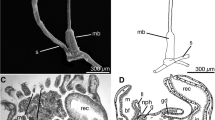Summary
Each second brain nerve consists of only one single fibre terminating at two different types of touch receptors in the oral region. The two nerves are the dendrites of two perikarya in the forebrain and are the master neurons for ciliary reversal in the stigmata, which is a two-neuron reflex. By axoaxonal synapses they control one motor neuron in the midbrain, i.e. the command neuron for ciliary reversal in both rings. This cell sends one axon branch in each third nerve to the cilia cells. In the left nerve this fibre is closely associated with a coarsely granulated accessory fibre, which apparently regulates the ciliary beat. The third nerves also contain one fibre each from another motor neuron in the hindbrain. These fibres make synaptic contacts at some specialized epidermal cells in the lateral trunk behind the ciliary rings. A few previously unknown nerves in the dorsal forebrain innervate epidermal cells. It is likely that the complicated epidermal motor innervation regulates the secretory activity of the oikoplasts or of the epidermal cells in constructing a new house, including the necessary complicated filters and food trapping mechanisms.
Similar content being viewed by others
References
Arkett SA (1987) Ciliary arrest controlled by identified central neurons in a urochordate (Ascidiacea). J Comp Physiol A. Sens Neurol Behav Physiol 161(6): 837–847
Bennett HS, Luft JH (1959) S-collidine as a basis for buffering fixatives. J Biophys Biochem Cytol 6:113–114
Berrill NJ (1950) “The Tunicata”. Ray Society, London, pp 1–354
Bollner T, Holmberg K, Olsson R (1986) A rostral sensory mechanism inOikopleura dioica (Appendicularia). Acta Zool (Stockholm) 67:235–241
Bone Q, Mackie GO (1982) Urochordata. In: Shelton GAR (ed) Electrical conduction and behaviour in ‘simple’ invertebrates. Clarendon Press, Oxford, pp 473–535
Bone Q, Gorski G, Pulsford AL (1979) On the structure and behaviour ofFritillaria (Tunicata: Larvacea). J Mar Biol Ass UK 59:399–411
Fenaux R (1971) La couche oikoplastique de l'AppendiculaireOikopleura albicans (Leukart) (Tunicata). Z Morphol Tiere 69:184–200
Fenaux R (1989) Les mechanismes de l'alimentation chez les appendiculaires. Océanis 15:31–37
Fol H (1872) Études sur les Appendiculaires du Détroit de Messine. Mém Soc Phys Hist Nat Genève 21:445–499
Galt CP, Mackie GO (1971) Electrical correlates of ciliary reversal inOikopleura. J Exp Biol 55:205–212
Georges D, Holmberg K, Olsson R (1988) The ventral midbrain cells inOikopleura dioica (Appendicularia). Acta Embryol Morphol Exp 9:39–47
Gorsky G, Palazzoli I (1989) Aspects de la biologie de l'AppendiculaireOikopleura dioica Fol 1872 (Chordata: Tunicata). Océanis 15:33–49
Holmberg K (1984) A transmission electron microscopic investigation of the sensory vesicle in the brain ofOikopleura dioica (Appendicularia). Zoomorphology 104:298–303
Körner WF (1952) Untersuchungen über die Gehäusebildung bei Appendicularien (Oikopleura dioica Fol.) Z Morphol Ökol Tiere 41:1–53
Lohmann H (1933) Appendiculariae. In: Kükenthal W (ed) Handbuch der Zoologie Bd 5∶2 Walter de Gruyter, Berlin
Mackie GO, Paul DH, Singla CL, Sleigh MA, Williams DE (1974) Branchial innervation and ciliary control in the ascidianCorella. Proc R Soc B 187:1–35
Mackie GO, Singla CL, Thiriot-Quievreux C (1976) Nervous control of ciliary activity in gastropod larvae. Biol Bull 151:182–199
Martini E (1909) Studien über die Konstanz histologischer Elemente IOikopleura longicauda. Z Wiss Zool 92:563–626
Olsson R (1969) Endocrinology of the Agnatha and Protochordata and problems of evolution of vertebrate endocrine systems. Gen Comp Endocrinol Suppl 2:485–499
Olsson R (1986) Basic design of the chordate brain. In: Uyeno T, Arai R, Taniuchi T, Matsuura K (eds) Proceed Second Intern Conference Indo-Pacific Fishes. Ichthyol Soc Japan, Tokyo, pp 86–93
Sakharov DA, Golubev AI, Malyutina LV, Kabotyanski EA, Nezlin LP (1988) Serotonergic control of ciliary locomotion in a turbellarian flatworm. Symp Biol Hung 36:479–491
Salensky W (1904) Études anatomiques sur les Appendiculaires. Mém Acad Sci St Petersbourg 15:135–150
Ussow MM (1876) Contribution to the organization of the Tunicates (in Russian). Mém Soc Imp Sci Nat Moskou 18(2): 1–62
Wood RL, Luft JH (1965) The influence of buffer systems on fixation with osmium tetroxide. J Ultrastruct Res 12:22–45
Author information
Authors and Affiliations
Rights and permissions
About this article
Cite this article
Olsson, R., Holmberg, K. & Lilliemarck, Y. Fine structure of the brain and brain nerves ofOikopleura dioica (Urochordata, Appendicularia). Zoomorphology 110, 1–7 (1990). https://doi.org/10.1007/BF01632806
Received:
Issue Date:
DOI: https://doi.org/10.1007/BF01632806




